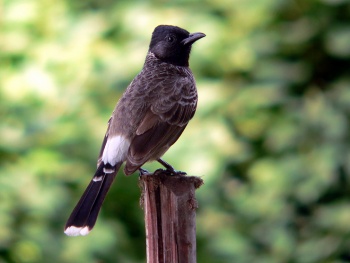Aloktewari (talk | contribs) (copyright symbol to images) |
|||
| Line 1: | Line 1: | ||
| − | [[Image:Red-vented_Bulbul2.jpg|thumb|550px|right|Ssp. ''cafer''<br />Photo by {{user|kctsang |kctsang}}<br />[[Sri Lanka]], July 2010]] | + | [[Image:Red-vented_Bulbul2.jpg|thumb|550px|right|Ssp. ''cafer''<br />Photo © by {{user|kctsang |kctsang}}<br />[[Sri Lanka]], July 2010]] |
;[[:Category:Pycnonotus|Pycnonotus]] cafer | ;[[:Category:Pycnonotus|Pycnonotus]] cafer | ||
==Identification== | ==Identification== | ||
| Line 11: | Line 11: | ||
*Long white-tipped tail<br /> | *Long white-tipped tail<br /> | ||
Sexes similar; young birds are duller | Sexes similar; young birds are duller | ||
| − | [[Image:12104redvented bulbul.jpg|thumb|350px|right|Ssp. ''humayuni''<br />Photo by {{user|Rajiv+Lather|Rajiv Lather}}<br />Karnal, [[India]], June 2006]] | + | [[Image:12104redvented bulbul.jpg|thumb|350px|right|Ssp. ''humayuni''<br />Photo © by {{user|Rajiv+Lather|Rajiv Lather}}<br />Karnal, [[India]], June 2006]] |
==Distribution== | ==Distribution== | ||
[[Asia]]: found in [[India]], [[Nepal]], [[Sri Lanka]], [[Myanmar]] and south-western [[China]]. | [[Asia]]: found in [[India]], [[Nepal]], [[Sri Lanka]], [[Myanmar]] and south-western [[China]]. | ||
| Line 19: | Line 19: | ||
==Taxonomy== | ==Taxonomy== | ||
====Subspecies==== | ====Subspecies==== | ||
| − | [[Image:redvented_bulbul_alok.JPG|thumb|350px|right|Ssp. ''intermedius''<br />Photo by {{user|aloktewari|Alok Tewari}}<br />Dwarahat, Uttarakhand [[Himalayas]], Alt. 5200 ft, [[India]], April-2017]] | + | [[Image:redvented_bulbul_alok.JPG|thumb|350px|right|Ssp. ''intermedius''<br />Photo © by {{user|aloktewari|Alok Tewari}}<br />Dwarahat, Uttarakhand [[Himalayas]], Alt. 5200 ft, [[India]], April-2017]] |
There are 9 subspecies<sup>[[#References|[1]]]</sup>: | There are 9 subspecies<sup>[[#References|[1]]]</sup>: | ||
*''P. c. intermedius'': [[Himalayas]] (western [[Pakistan]] to western Uttar Pradesh) | *''P. c. intermedius'': [[Himalayas]] (western [[Pakistan]] to western Uttar Pradesh) | ||
Revision as of 02:57, 9 October 2019
- Pycnonotus cafer
Identification
19–20 cm (7½-8 in)
- Brownish-black upperparts
- White rump
- Brownish-black breast
- White underparts
- Red around the vent
- Black head and small bushy crest
- Long white-tipped tail
Sexes similar; young birds are duller
Distribution
Asia: found in India, Nepal, Sri Lanka, Myanmar and south-western China.
They have been introduced to many areas including Fiji, Hawaii, Texas, Bahrain, Argentina, Samoa,and Tonga. They are also commonly seen in urban parts of Dubai, the United Arab Emirates.
Taxonomy
Subspecies

Photo © by Alok Tewari
Dwarahat, Uttarakhand Himalayas, Alt. 5200 ft, India, April-2017
There are 9 subspecies[1]:
- P. c. intermedius: Himalayas (western Pakistan to western Uttar Pradesh)
- P. c. humayuni: Pakistan (Salt Range) and north-western India
- P. c. bengalensis: Eastern Himalayas (eastern Uttar Pradesh) to north-eastern India, Nepal and Bhutan
- P. c. wetmorei: North-eastern peninsula India
- P. c. primrosei: Southern Assam (south of the Brahmaputra), Bangladesh and West Bengal
- P. c. pusillus South India (Bombay, Madhya Pradesh and Andhra to Kerala)
- P. c. cafer: Sri Lanka
- P. c. stanfordi: Northern Burma to extreme south-western China (western Yunnan)
- P. c. melanchimus: South-central Burma (Mandalay to Rangoon)
Habitat
Scrub, open dry deciduous woodland, plains and cultivated land, orchards and gardens.
Behaviour
Breeding
They builds their nest in a bush; the clutch consists of 2-3 eggs.
Diet
The diet includes fruit, buds, nectar, insects and invertebrates.
Vocalisation
A very noisy species
<flashmp3>red-vented_bulbul_alok.mp3</flashmp3>
Listen in an external program
Recording by Alok Tewari
Janakpuri, Delhi, India, Sep.-2016
Call recorded in an urban garden, 7.15 am.
References
- Clements, J. F., T. S. Schulenberg, M. J. Iliff, D. Roberson, T. A. Fredericks, B. L. Sullivan, and C. L. Wood. 2017. The eBird/Clements checklist of birds of the world: v2017, with updates to August 2017. Downloaded from http://www.birds.cornell.edu/clementschecklist/download/
- PBase
- Handbook of the Birds of the World Alive (retrieved July 2015)
Recommended Citation
- BirdForum Opus contributors. (2024) Red-vented Bulbul. In: BirdForum, the forum for wild birds and birding. Retrieved 18 May 2024 from https://www.birdforum.net/opus/Red-vented_Bulbul
External Links





